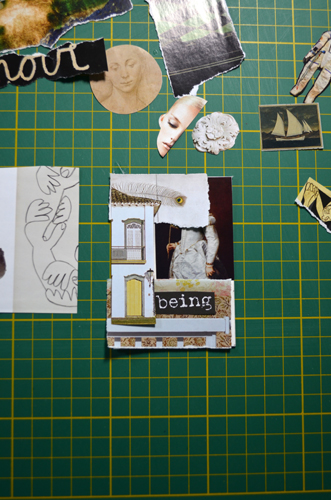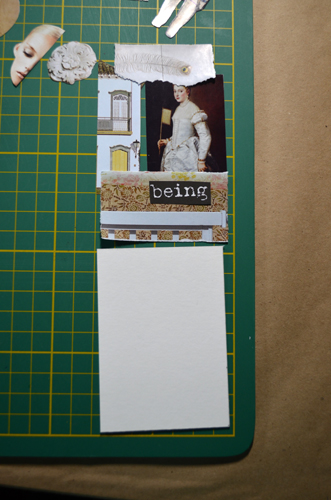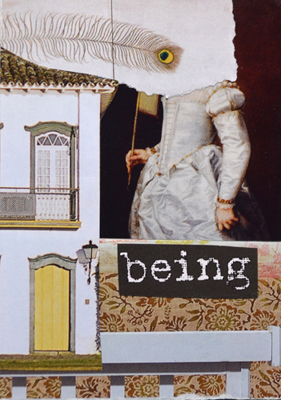Today I thought I’d share some tips on creating a collage Artist Trading Card (ATC) with you. Rather then working with a theme, sometimes I like to throw caution to the wind by letting my ATC create itself (so to speak). Here’s some insight into the process using my latest ATC creation (shown above): “Being”…
Selecting Images…
With “Being” I set a simple goal of creating an ATC with a more or less monochromatic colour palette with a couple of pops of colour. I began by selecting 25 small images* and text from leftover magazine scraps. While selecting images, I noticed the ones with creamy/white and gold tones appealed to me so I grouped them together; this narrowed my images down to about 15 pieces.
Arranging Images…
Next, I randomly selected images and arranged them on my card in different positions to see how they worked together. At this stage I like to play with the visual elements of my collage. I like to suggest a story so I pick a character and create a setting for them to inhabit; something that will reveal their history or personality. In the photo above, you’ll notice six potential characters for my story: three different women, an astronaut, a half torso and even a sailing ship. Of these I decided I liked the image of the torso, two of the women and the astronaut. I worked with these continually re-arranging them with settings and objects until I arrived at a composition I liked.

Step 3: Compose your collage with the pieces that feel "right" to you... also use the strategies described below to help you
When Composing…
I use these tactics (quite unconsciously) in my collaging; it’s good to be aware of them when you don’t know what to do or when you’re stuck.
1 Ensure contrasting colours: dark and light work well together… as they draw the eye in and out of the picture plane. For example, in my ATC, note how the blackness behind the girl becomes a room the viewer’s eye can enter while the light feather background, house façade and wall paper become architectural elements that tease us by enclosing and shielding parts of her from view. Dark and light colours also give the image a dramatic, theatrical edge.
2 Use compositional lines effectively so that they encourage viewers to explore the entire surface area of your collage. In “Being” see how the feather on the top-left corner draws the viewer to the girl on the right side whose hand points to the word “Being” which hovers over the white banister which connects to the house on the left side whose pointed roof draws us back up to the feather – thus giving us a whole tour of the card!
3 Use interesting textural elements in your collage to engage viewers. In my ATC, these are found in the satiny shadows of the girl’s dress; the patterned floral wallpaper; the intricate design on the white door and the detailed mysterious peacock feather which conceals her face adding further intrigue.
4 Make use of repetition in your collage by repeating similar: colours, lines and shapes. In “Being” you’ll notice the yellow door at the bottom of the card echoes the yellow of the peacock feather above it; that the lines of the feather echo the lines of the white banister along the bottom of the card. Using this strategy helps to unify the collage.
Finding the Right Text…
Text is the final layer I add after I’ve had a chance to fully contemplate the meaning of my collage. I’m not sure why, but from the start, I was drawn to the word “Being”. When choosing words, keep in mind their: shape, font-type, colour, clarity (heaviness, crispness, lightness) and size contribute to their visual character as well as the possibility of adding further emotional and psychological depth to your piece. Here I loved the ghostly ephemeral feel of the old-fashioned typewriter Courier style font used for “Being” … it’s as though it might disappear at any moment! Had it been typed in bold, in another colour or in another font, I don’t think I would have felt it belonged in my collage and I’d have searched for another word. Adding text, however, is optional – so do what you feel is in keeping with the mood you want to create… for some, the images speak for themselves.

Final Step: Before gluing your pieces down remember it's never too late to try other image combinations to ensure you do indeed have the right pieces!
Final Thoughts…
At the pre-gluing stage, remember it’s never too late to try out other fragment combinations before you finally cut and glue your material down. Ask yourself if everything works together as a cohesive unit… here wait a few hours or a day or even ask for someone’s opinion on your collage.
Remember too, collaging is part of your fantasy world, so anything goes… any images whether they’re from the same time period/era, will look like they’re connected once you thoughtfully cut or tear them and glue them onto your card… everything has the potential to belong if you create the right conditions for it. This happens when you are “listening” or becoming in tune with the pieces you select.
* Note: It can be quite challenging to find images that fit the ATC card size: 2.5 x 3.5 inches. I search for fairly small images or tear fragments from larger images as well as get most of my images from the back sections of interior decorating, art and fashion magazines where they have mini photos of products, artworks and people, respectively.
Trade an ATC with Me!
Thanks for taking the time to review the process – I’d love to know if it works for you. As a bonus, I’ll be happy to trade cards with the first person who comments on this blog post!




Thanks for taking time to write this great blog post Michelle!!!It is so interesting that i printed it to have it at hand and follow your advices in future collages!
Hi Jeanne-Sylvie, Thank YOU for taking the time to review it! 🙂 I’m so glad it proved useful to you. Yes, it’s great for collaging in general, not just ATCs! I would love to see what you do with this method in the future. Take care, Michelle